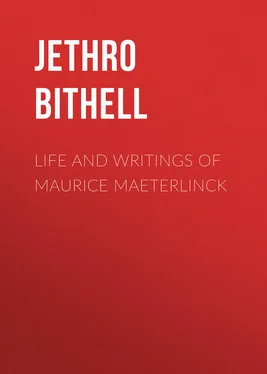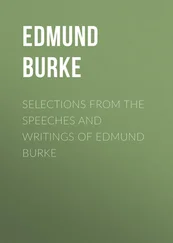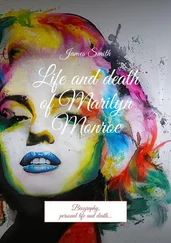Jethro Bithell - Life and Writings of Maurice Maeterlinck
Здесь есть возможность читать онлайн «Jethro Bithell - Life and Writings of Maurice Maeterlinck» — ознакомительный отрывок электронной книги совершенно бесплатно, а после прочтения отрывка купить полную версию. В некоторых случаях можно слушать аудио, скачать через торрент в формате fb2 и присутствует краткое содержание. ISBN: , Жанр: foreign_antique, foreign_prose, на английском языке. Описание произведения, (предисловие) а так же отзывы посетителей доступны на портале библиотеки ЛибКат.
- Название:Life and Writings of Maurice Maeterlinck
- Автор:
- Жанр:
- Год:неизвестен
- ISBN:http://www.gutenberg.org/ebooks/38917
- Рейтинг книги:3 / 5. Голосов: 1
-
Избранное:Добавить в избранное
- Отзывы:
-
Ваша оценка:
- 60
- 1
- 2
- 3
- 4
- 5
Life and Writings of Maurice Maeterlinck: краткое содержание, описание и аннотация
Предлагаем к чтению аннотацию, описание, краткое содержание или предисловие (зависит от того, что написал сам автор книги «Life and Writings of Maurice Maeterlinck»). Если вы не нашли необходимую информацию о книге — напишите в комментариях, мы постараемся отыскать её.
Life and Writings of Maurice Maeterlinck — читать онлайн ознакомительный отрывок
Ниже представлен текст книги, разбитый по страницам. Система сохранения места последней прочитанной страницы, позволяет с удобством читать онлайн бесплатно книгу «Life and Writings of Maurice Maeterlinck», без необходимости каждый раз заново искать на чём Вы остановились. Поставьте закладку, и сможете в любой момент перейти на страницу, на которой закончили чтение.
Интервал:
Закладка:
Out of twenty pupils in the highest class at Sainte-Barbe fourteen were intended to be Jesuits or priests. Such a school was not likely to be a good training-place for poets. Indeed, though Latin verses were allowed, it forbade the practice of vernacular poetry. 11 11 Anselma Heine, Maeterlinck , p. 9. But cf. Léon Bazalgette, Emile Verhaeren , p. 14.
And yet this very school has turned out not less than five poets of international reputation. Emile Verhaeren (who may be called the national poet of Flanders, the most international of French poets after Victor Hugo) and Georges Rodenbach had been schoolboys together at Sainte-Barbe; and on its benches three other poets, Maeterlinck, Grégoire Le Roy, and Charles van Lerberghe, formed friendships for life. These three boys put their small cash together and subscribed to La Jeune Belgique , the clarion journal which, under the editorship of Max Waller, was calling Belgian literature into life; they devoured its pages clandestinely, as other schoolboys smoke their first cigarettes; 12 12 Gérard Harry, Maeterlinck , p. 9, note.
and Maeterlinck even sent in a poem which was accepted and printed. This was in 1883.
The fact that Maeterlinck was reading La Jeune Belgique shows that he was already spoilt for a priest. But he was essentially religious; and his career has proved that he was one of those poets Verhaeren sings of, who have arrived too late in history to be priests, but who are constrained by the force of their convictions to preach a new gospel. It was the religion inborn in him, as well as his monastic training, which made him a reader and interpreter of such mystics as Ruysbroeck, Jakob Boehme, and Swedenborg. As a schoolboy he did not feel attracted to poetry alone; he had a great liking for science, and his great wish was to study medicine. 13 13 Gérard Harry, Maeterlinck , p. 26; Heine, Maeterlinck , p. 9.
Some time ago he wrote to a French medical journal as follows:
"I never commenced the study of medicine. I did my duty in conforming with the family tradition, which ordains that the eldest son shall be an avocat . I shall regret to my last day that I obeyed that tradition, and consecrated my most precious years to the vainest of the sciences. All my instincts, all my inclinations, attached me to the study of medicine, which I am more than convinced is the most beautiful of the keys that give access to the great realities of life."
It was in 1885 that he entered the University of Ghent as a student of law. Like Lessing and Goethe, he had no respect for his professors. He was again a fellow-student of van Lerberghe and Le Roy; they also were students of jurisprudence. He was twenty-four when, according to his parents' wish, he settled in Ghent as an avocat ; to lose, as Gérard Harry puts it, "with triumphant facility the first and last causes which were confided to him." His shyness and the thin, squeaking voice in his robust peasant's frame were against him in a profession which in any case he hated. He practised for a year or so, and then – "il a jeté la toque et la robe aux orties."
In 1886 he set out for Paris, ostensibly with the object of completing his legal education there. Grégoire Le Roy accompanied him; and each stayed about seven months. They had lodgings at 22 Rue de Seine. Grégoire Le Roy scamped painting at the Ecole St Luc and the Atelier Gervex et Humbert; and the pair of them spent a great deal of time in the museums. But the important thing in their stay in Paris was that they came into contact with men of letters. In the Brasserie Pousset at the heart of the Quartier Latin they heard Villiers de L'Isle-Adam, "that evangelist of dream and irony," reciting his short stories before writing them down. "I saw Villiers de L'Isle-Adam very often during the seven months I spent at Paris," Maeterlinck told Huret. "All I have done I owe to Villiers, to his conversation more than to his works, though I admire the latter exceedingly." Villiers was twenty-two years older than Maeterlinck, having been born in 1840; but his masterpieces had not long been published, and it was only in the later 'eighties that the young poets who were to be known as symbolists began to gather round him, as they gathered round Mallarmé and Verlaine.
Villiers de L'Isle-Adam died in Paris in 1889. In the same year died, also in Paris, another writer who might be proved to have influenced Maeterlinck, 14 14 Cf., for instance, Barbey's "Réfléchir sur son bonheur n'est-ce pas le doubler?" with the opening chapters of Sagesse et Destinée .
even if the latter had not placed on record his high admiration of him. This was Jules Barbey d'Aurevilly (born 1808). Maeterlinck, after the banquet offered to him by the city of Brussels on the occasion of his receiving the Nobel prize, wrote despondently, expressing the good omen, seeing that men of real genius like Villiers de L'Isle-Adam and Barbey d'Aurevilly had died in obscurity and poverty. Both men, indeed, had been hostile to cheap popularity. Barbey lived, to quote Paul Bourget, "in a state of permanent revolt and continued protest." He had written scathing attacks on the Parnassians. Both poets were idealists among the naturalists; their idealism is a bridge spanning naturalism and joining the romanticists with the symbolists or neo-romanticists.
Villiers was a king in exile on whom the young squires attended. But they themselves had their spurs to win; and it was the greatest good fortune for Maeterlinck that he was able to join their company and take part in their campaign. Several of them, Jean Ajalbert, Ephraïm Mikhaël, Pierre Quillard, had already been contributing to La Basoche , a review published at Brussels. There was Rodolphe Darzens, who, two years later, was to anticipate Maeterlinck in writing a play on Mary Magdalene. There was Paul Roux, who, as time went on, blossomed into "Saint-Pol-Roux le Magnifique" – he who founded "le Magnificisme," the school of poetry which had for its programme "a mystical magnificat to eternal nature." It was in Pierre Quillard's rooms one evening that Grégoire Le Roy read to this circle of friends a short story by Maeterlinck: Le Massacre des Innocents . On the day following he introduced the author of the tale. On the 1st March, 1886, these young writers founded La Pléiade , 15 15 The review of the same name which was published at Brussels, by Lacomblez, beginning three years later, and in which Maeterlinck's criticism of Iwan Gilkin's Damnation de l'Artiste appeared, was a third-rate periodical.
a short-lived review – six numbers appeared – which nevertheless played an important part. Beside the authors mentioned, it published contributions from René Ghil. It had the glory of printing the first verses of Charles van Lerberghe, and, in addition to several poems which were to appear in Serres Chaudes , Maeterlinck's Massacre des Innocents (May, 1886).
Le Massacre des Innocents was signed "Mooris Maeterlinck." The author discarded it; but it was reprinted in Gérard Harry's monograph (1909). A translation by Edith Wingate Rinder appeared at Chicago in 1895. 16 16 The Massacre of the Innocents and other Tales by Belgian Writers.
It is a story which reproduces the delightful quaintness of early Dutch and Flemish painting:
"There were thirty horsemen or thereabouts, covered with armour, round an old man with a white beard. On the croup of their horses rode red or yellow lansquenets, who dismounted and ran across the snow to stretch their limbs, while several soldiers clad in iron dismounted also, and pissed against the trees they had tied their horses to.
"Then they made for the Golden Sun Inn, and knocked at the door, which was opened reluctantly, and they went and warmed themselves by the fire while beer was served to them.
Читать дальшеИнтервал:
Закладка:
Похожие книги на «Life and Writings of Maurice Maeterlinck»
Представляем Вашему вниманию похожие книги на «Life and Writings of Maurice Maeterlinck» списком для выбора. Мы отобрали схожую по названию и смыслу литературу в надежде предоставить читателям больше вариантов отыскать новые, интересные, ещё непрочитанные произведения.
Обсуждение, отзывы о книге «Life and Writings of Maurice Maeterlinck» и просто собственные мнения читателей. Оставьте ваши комментарии, напишите, что Вы думаете о произведении, его смысле или главных героях. Укажите что конкретно понравилось, а что нет, и почему Вы так считаете.












